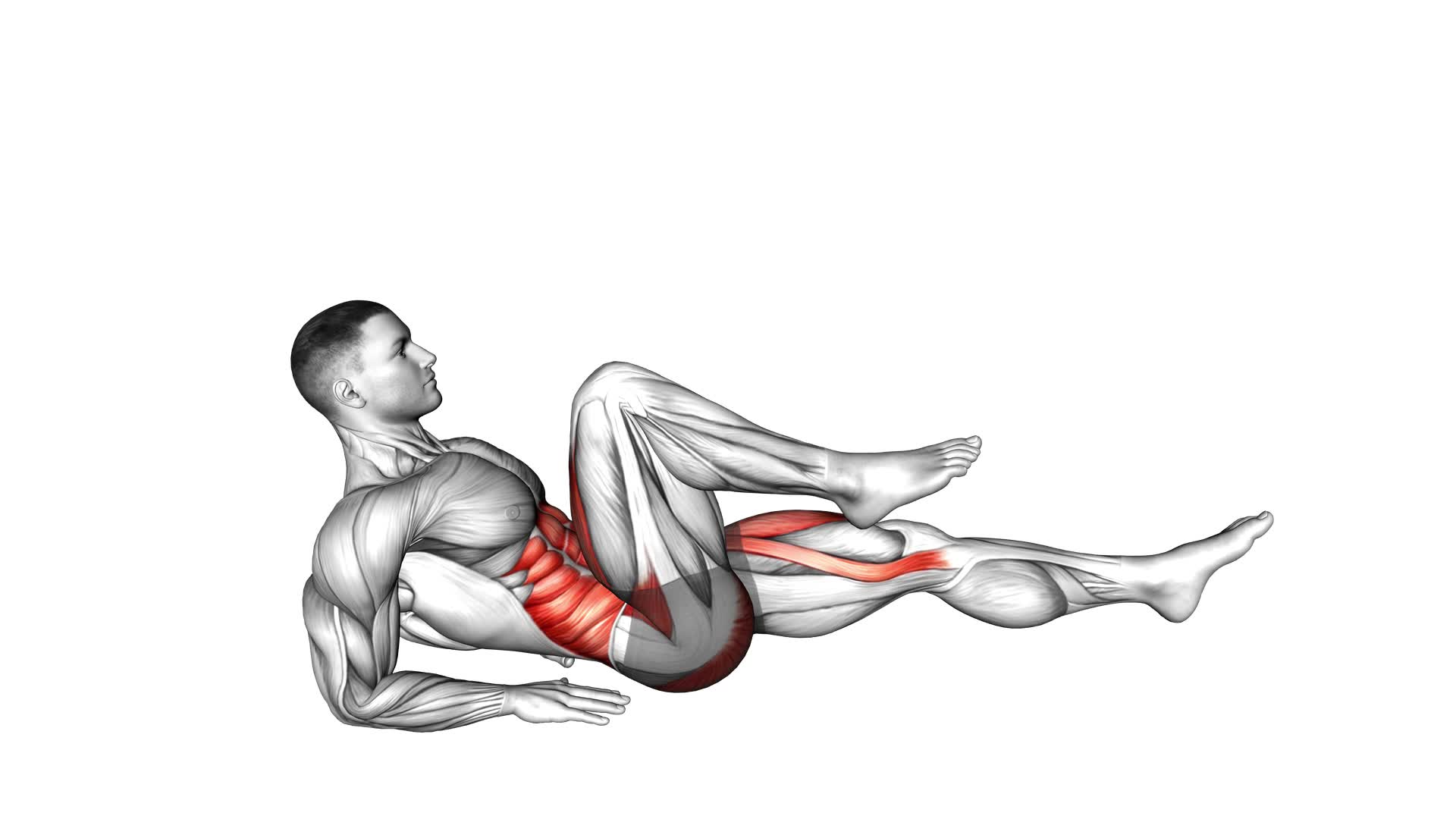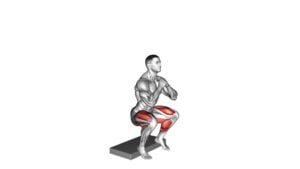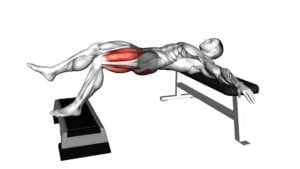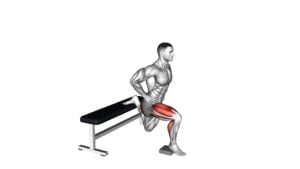Elevated Cycling (male) – Video Exercise Guide & Tips

Are you looking for a new and challenging workout routine? Look no further than elevated cycling!
Watch This Exercise Video
In this video exercise guide, we'll show you the proper technique and essential equipment needed for an effective elevated cycling workout.
Not only will you target your lower body muscles, but we'll also provide tips to help you maximize your workout.
Get ready to pedal your way to fitness with this intense and exhilarating exercise.
Key Takeaways
- Elevated cycling is beneficial for cardiovascular endurance and heart health.
- Proper technique includes adjusting seat height, maintaining proper form, and focusing on efficient breathing.
- Essential equipment includes a stationary bike with adjustable resistance levels, comfortable seat, cycling shoes with cleats, and a properly fitted bike and helmet for safety.
- Targeted lower body muscles in elevated cycling include quadriceps, hamstrings, glutes, and calves, with variations like squats, lunges, calf raises, leg press machine, and deadlifts.
Benefits of Elevated Cycling
Experience the increased cardiovascular endurance and strengthened leg muscles that come from engaging in elevated cycling.
Elevated cycling, also known as cycling uphill or on an inclined surface, offers numerous benefits for improving cardiovascular health and aiding in weight loss.
When you pedal against gravity, your heart rate increases, and your lungs work harder to supply oxygen to your muscles. This constant effort helps to improve your cardiovascular endurance, making your heart stronger and more efficient at pumping blood.
Additionally, cycling uphill requires your leg muscles to work harder, particularly your quadriceps, hamstrings, and glutes. Over time, this can lead to increased muscle strength and tone in your lower body.
Furthermore, engaging in elevated cycling can be an effective way to burn calories and assist with weight loss. The combination of the uphill terrain and the increased effort required can help you to burn more calories compared to cycling on a flat surface.
Incorporating elevated cycling into your fitness routine can be a challenging but rewarding way to improve your cardiovascular health and work towards your weight loss goals.
Proper Technique for Elevated Cycling
To properly execute elevated cycling, follow these steps to ensure an efficient and effective workout:
- Begin by adjusting the seat height so that your legs are almost fully extended when the pedals are at the lowest point. This will allow for optimal power transfer and reduce strain on your knees.
- Maintain proper form by keeping your back straight, shoulders relaxed, and elbows slightly bent. This will help to prevent unnecessary strain on your upper body.
- Focus on efficient breathing throughout your workout. Take deep breaths in through your nose and exhale fully through your mouth. This will help to oxygenate your muscles and increase endurance.
- Gradually increase the intensity of your workout by adjusting the resistance on the bike. Start with a moderate level and slowly increase it as you build strength and stamina.
- Incorporate interval training into your elevated cycling routine. Alternate between periods of high-intensity cycling and lower-intensity recovery periods. This will help to improve cardiovascular fitness and burn more calories.
Essential Equipment for Elevated Cycling
To get the most out of your elevated cycling workouts, you'll need a few essential pieces of equipment. Whether you prefer indoor cycling or outdoor cycling, having the right gear is crucial for an effective and safe workout.
For indoor cycling, a stationary bike is the main equipment you'll need. Look for a bike that has adjustable resistance levels and a comfortable seat. You may also want to invest in cycling shoes with cleats that can be attached to the pedals for better stability and power transfer.
If you prefer outdoor cycling, a road bike or a mountain bike is recommended, depending on your terrain preferences. Make sure your bike is properly fitted to your body to prevent any discomfort or injuries. Also, don't forget to wear a helmet for safety.
In addition to the bike, it's important to have proper cycling attire. Wear moisture-wicking clothing that allows for freedom of movement. Consider investing in padded cycling shorts to enhance comfort during longer rides.
Now that you know the essential equipment for elevated cycling, let's move on to the next section where we'll discuss the targeted lower body muscles in elevated cycling.
Targeted Lower Body Muscles in Elevated Cycling
Let's talk about the targeted lower body muscles in elevated cycling. When you engage in this exercise, you efficiently target your leg muscles, including your quadriceps, hamstrings, and glutes. This helps to strengthen and tone your lower body while improving your overall cycling performance.
Additionally, there are variations of elevated cycling that allow you to target specific areas of your lower body, such as single-leg cycling or adding resistance for an extra challenge.
Efficient Leg Muscle Targeting
Focus on targeting specific lower body muscles efficiently during elevated cycling by incorporating exercises that engage and activate those muscle groups. By doing so, you can enhance your workout and achieve better results.
Here are some exercises to help you efficiently target your leg muscles during elevated cycling:
- Squats: This exercise primarily targets your quadriceps, hamstrings, and glutes, improving your lower body strength and power.
- Lunges: Lunges engage your quadriceps, hamstrings, and glutes, while also improving your balance and stability.
- Calf raises: This exercise specifically targets your calf muscles, helping to strengthen and tone them.
- Leg press: The leg press machine allows you to target your quadriceps, hamstrings, and glutes, providing a challenging workout for your lower body.
- Deadlifts: Deadlifts target your hamstrings, glutes, and lower back, helping to develop overall lower body strength and stability.
Benefits of Elevated Cycling
Improve your lower body strength and target specific muscles with elevated cycling. This form of exercise not only helps you build muscle but also offers numerous benefits for your cardiovascular health and weight loss goals.
By engaging in elevated cycling, you can enhance your cardiovascular endurance, leading to a stronger heart and improved overall fitness. The repetitive motion of pedaling in an elevated position also burns calories, making it an effective tool for weight loss.
Additionally, elevated cycling specifically targets the lower body muscles, including the quadriceps, hamstrings, glutes, and calves. As you pedal against resistance, these muscles are strengthened and toned, resulting in improved muscle definition and increased lower body strength.
Incorporating elevated cycling into your fitness routine can help you achieve your goals of improved cardiovascular health and weight loss.
Variations for Lower Body
Challenge and strengthen your lower body muscles with these variations of elevated cycling. Here are some variations that target different muscles in your lower body:
- Variations for Lunges: Incorporate lunges into your elevated cycling routine by alternating between cycling and lunging movements. This will engage your quadriceps, hamstrings, and glutes even more.
- Benefits of Squats: Squats are a great addition to elevated cycling as they target your quadriceps, hamstrings, and glutes. By adding squats, you can enhance the strength and stability of your lower body muscles.
- Split Squats: Step one foot forward and the other foot back, then lower your back knee towards the ground while maintaining an elevated cycling motion. This variation will intensify the engagement of your quadriceps and glutes.
- Single-Leg Cycling: Lift one foot off the elevated cycling platform and cycle using only the other leg. This variation challenges your balance and works your quadriceps and glutes on one leg at a time.
- Resistance Bands: Incorporate resistance bands around your thighs or ankles while performing elevated cycling. This will add extra resistance and help target your lower body muscles even more.
Tips to Maximize Your Elevated Cycling Workout
To maximize your elevated cycling workout, it's important to focus on proper form techniques. This includes maintaining a neutral spine, engaging your core, and keeping your shoulders relaxed.
Additionally, pay attention to your breathing, inhaling deeply through your nose and exhaling fully through your mouth.
Lastly, gradually increase the resistance levels on your bike to challenge your muscles and continually progress in your fitness journey.
Proper Form Techniques
Maintain proper form throughout your elevated cycling workout to optimize results and prevent injury. Here are some tips to help you master the proper form techniques for your elevated cycling workout:
- Efficient Pedaling Technique: Focus on keeping a smooth and fluid motion while pedaling. Avoid applying too much force on the pedals, as it can strain your muscles and joints.
- Maintain Correct Body Position: Keep your back straight and your shoulders relaxed. Avoid hunching over the handlebars, as it can lead to back pain and poor posture.
- Proper Seat Height: Adjust your seat height so that your legs are slightly bent at the bottom of the pedal stroke. This will help you generate power and prevent strain on your knees.
- Avoid Gripping the Handlebars Too Tightly: Maintain a light grip on the handlebars to prevent unnecessary tension in your upper body.
- Common Mistakes in Elevated Cycling Technique: Be mindful of common mistakes, such as bouncing up and down on the saddle or rocking your body from side to side. These movements waste energy and can lead to discomfort or injury.
By mastering these proper form techniques, you'll be able to maximize the effectiveness of your elevated cycling workout.
Now let's move on to the next section, where we'll discuss breathing techniques for endurance.
Breathing for Endurance
Breathe deeply and rhythmically to enhance your endurance during an elevated cycling workout. Proper breathing techniques play a crucial role in maximizing your cardiovascular endurance.
When cycling at an elevated intensity, it's important to focus on your breath to sustain your effort and improve your overall performance. Deep breathing allows for more oxygen to be delivered to your muscles, increasing their efficiency and reducing fatigue.
To achieve this, inhale deeply through your nose and exhale fully through your mouth, matching your breath with the rhythm of your pedal strokes. By maintaining a steady, controlled breathing pattern, you can optimize your oxygen intake and carbon dioxide release, enabling you to sustain your effort for longer periods and reach your fitness goals more effectively.
Increasing Resistance Levels
To maximize your elevated cycling workout, it's important to gradually increase the resistance levels, allowing your muscles to adapt and grow stronger over time. Increasing the intensity of your cycling sessions through resistance training can help you reach your fitness goals faster and improve your overall performance.
Here are five tips to help you maximize your elevated cycling workout:
- Start with a comfortable resistance level and gradually increase it as you get stronger.
- Focus on maintaining proper form and technique while cycling to prevent injuries.
- Incorporate interval training into your workouts by alternating between high resistance and lower resistance intervals.
- Use a heart rate monitor to track your intensity levels and ensure you're challenging yourself enough during your workouts.
- Listen to your body and give yourself time to recover between sessions to avoid overtraining.
Sample Elevated Cycling Workout Routine
Complete an intense 30-minute elevated cycling workout that will challenge your endurance and build your lower body strength.
This sample elevated cycling workout routine is designed to efficiently target your leg muscles and provide you with an effective cardio workout.
Start with a 5-minute warm-up, gradually increasing the resistance and speed.
Once warmed up, increase the resistance to a challenging level and maintain a moderate pace for 3 minutes.
Then, increase the resistance even further and pedal as fast as you can for 1 minute to really push your cardiovascular system.
After the intense burst, decrease the resistance and recover for 2 minutes at a slower pace.
Repeat this cycle of high-intensity and recovery intervals for a total of 30 minutes.
Remember to listen to your body and adjust the resistance and speed as needed.
Finish the workout with a 5-minute cool down, gradually decreasing the intensity.
Incorporating this sample elevated cycling workout routine into your fitness regimen will help you improve your endurance, strengthen your leg muscles, and burn calories efficiently.
Frequently Asked Questions
How Long Should a Typical Elevated Cycling Workout Session Last?
For an optimal elevated cycling workout session, it's important to consider the benefits and duration.
Elevated cycling offers numerous benefits such as cardiovascular endurance, lower body strength, and calorie burning.
As for the workout duration, it generally depends on your fitness level and goals. A typical session can range from 30 to 60 minutes.
It's recommended to start with shorter durations and gradually increase as you build stamina and strength.
Remember to listen to your body and adjust accordingly.
Can Elevated Cycling Help With Weight Loss and Calorie Burning?
Elevated cycling can be an effective tool for weight loss and calorie burning. By incorporating this exercise into your routine, you can benefit from the increased intensity and resistance it offers.
To maximize your results, it's important to follow best practices for elevated cycling, such as maintaining proper form, adjusting the resistance level to challenge yourself, and incorporating intervals or varied intensity.
Consistency and proper technique are key to achieving your weight loss goals with elevated cycling.
Is Elevated Cycling Suitable for Beginners or Is It More Advanced?
Elevated cycling can be both beginner friendly and advanced level. It offers a challenging workout that can be adjusted to your fitness level.
As a beginner, you can start with lower resistance and shorter durations, gradually increasing as you build strength and endurance. Advanced individuals can push themselves with higher resistance and longer durations to intensify the workout.
Just remember to listen to your body and take breaks when needed.
Are There Any Specific Warm-Up Exercises Recommended Before Starting an Elevated Cycling Workout?
Before starting an elevated cycling workout, it's important to incorporate specific warm-up exercises. These exercises help prepare your muscles and joints for the intensity of the workout.
Warm-up exercises for elevated cycling can include dynamic stretches, such as leg swings and arm circles, as well as some light cardio activities like jogging or jumping jacks.
Can Elevated Cycling Help Improve Cardiovascular Fitness?
Elevated cycling is a great way to improve your cardiovascular fitness. It offers numerous benefits for your heart health and overall fitness. By engaging in this exercise, you can increase your heart rate, strengthen your heart muscle, and improve blood circulation throughout your body.
This form of exercise also helps to burn calories, reduce body fat, and improve endurance. Incorporating elevated cycling into your workout routine can have a positive impact on your cardiovascular health.
Conclusion
In conclusion, elevated cycling is a highly effective exercise that offers numerous benefits for the lower body muscles.
By using proper technique and essential equipment, individuals can maximize their workout and achieve optimal results.
Whether you're a beginner or an experienced cyclist, incorporating elevated cycling into your fitness routine can help improve strength, endurance, and overall cardiovascular health.
Remember to follow the tips provided and try out the sample workout routine to make the most out of your elevated cycling sessions.

Author
Years ago, the spark of my life’s passion ignited in my mind the moment I stepped into the local gym for the first time. The inaugural bead of perspiration, the initial endeavor, the very first surge of endorphins, and a sense of pride that washed over me post-workout marked the beginning of my deep-seated interest in strength sports, fitness, and sports nutrition. This very curiosity blossomed rapidly into a profound fascination, propelling me to earn a Master’s degree in Physical Education from the Academy of Physical Education in Krakow, followed by a Sports Manager diploma from the Jagiellonian University. My journey of growth led me to gain more specialized qualifications, such as being a certified personal trainer with a focus on sports dietetics, a lifeguard, and an instructor for wellness and corrective gymnastics. Theoretical knowledge paired seamlessly with practical experience, reinforcing my belief that the transformation of individuals under my guidance was also a reflection of my personal growth. This belief holds true even today. Each day, I strive to push the boundaries and explore new realms. These realms gently elevate me to greater heights. The unique combination of passion for my field and the continuous quest for growth fuels my drive to break new ground.



